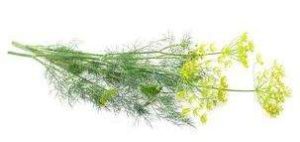Dill
The Herb Dill
Dill is a delicious fresh herb in sauces. Of course, it can be used in even more dishes and has specific properties.
Curious which ones?
Read more about it here.
Characteristics Dill
- Family: Umbelliferae
- Type of dill: Anethum graveolens
- Biotope: Fertile, permeable soil; southern Europe to India.
- Originates from: Greece
- Height: up to 60 cm
Dill is an annual plant and has blue-green, thread-like leaves. In the summer, the plant forms (yellow) umbels.

The flowers eventually become heads with oval seeds.
Anethum sowa is also called Indian or Japanese dill.
Name in Different Languages
- English: Dill
- German: Dille
- French: Aneth
- Italian: Aneto
- Spanish: Eneldo
Use and Application of Dill
Dill has a fresh but dominant flavor. Dried dill is often less tasty, as it quickly develops an aftertaste.
Dill seed is soft, sweet, and spicy and should be used sparingly.
The most delicate taste is fresh, unripe, green seed heads.
These heads add flavor to dill pickles, vinegar, Gravad Lax, and potato salad.
Dill in the Kitchen
Unripe leaves are seasoning for sour cream, yogurt dishes, sauces, salads, meat, and fish dishes.
The seeds are rich in minerals and suitable for a low-salt diet.
These seeds are mainly used in Scandinavia and Eastern Europe (spicy and sweet dishes).
They are used in vegetables, soups, salads, sauces, and stewed fish in many kitchens.
The Healthy Properties of Dill
The seeds promote digestion.
An infusion of the seeds reduces:
- Hiccups
- Abdominal pain
- Insomnia
- Flatulence
The distilled oil of the leaves gives flavor to drinks and food.